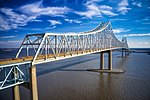Wade Dump

Wade Dump was a rubber recycling facility and illegal industrial waste storage and disposal facility in Chester, Pennsylvania. It was located at 1 Flower Street on the western bank of the Delaware River just north of the Commodore Barry Bridge. In 1978, a fire at the site burned out of control for several days, injuring firefighters and leading to the owner's conviction and imprisonment. Many of the first responders to the fire suffered long-term health consequences and higher-than-normal cancer rates. In 1983, the site was designated a Superfund cleanup site by the Environmental Protection Agency (EPA) and was remediated in stages over six years. It was removed from the National Priorities List in 1989. In 2004, it was turned into a parking lot for the city's Barry Bridge Park with approval from the state and the EPA. The sixth five year review of the site conducted by the EPA in 2018 concluded that the site continues to be protective of human health and the environment. Groundwater monitoring was discontinued in 2018 and the monitoring wells decommissioned. Periodic inspections of the site are ongoing.
Excerpt from the Wikipedia article Wade Dump (License: CC BY-SA 3.0, Authors, Images).Wade Dump
Flower Street,
Geographical coordinates (GPS) Address Nearby Places Show on map
Geographical coordinates (GPS)
| Latitude | Longitude |
|---|---|
| N 39.834336 ° | E -75.377632 ° |
Address
Flower Street 2
19013
Pennsylvania, United States
Open on Google Maps







